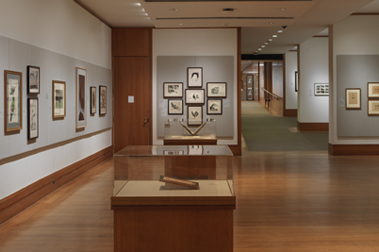The Nymph of Fontainebleau
René Boyvin French
Pierre Milan French
Not on view
Although produced in Paris, this engraving emblematizes much of the style and spirit of Fontainebleau. The elaborate framework, composed of animated caryatids intertwined with thick leather strapwork and pendulous garlands of fruit—and further enlivened by infant musicians and peculiar-looking dogs—is characteristic of the decoration of the Gallery of Francis I, and indeed reproduces with minor variations a frame that can still be seen in the Gallery. The central image, which, as the inscription tells us, is based on a design by Rosso Fiorentino, forms no part of the surviving decorations but represents the legendary origins of Fontainebleau. According to a seventeenth-century account, a hound named Bilaud discovered a hidden pool fed by a pure spring—this font of Bilaud became shortened to 'Fontainebleau.' The hound calls to mind the function of the building as a hunting lodge, while the nymph who personifies the stream, with her elongated limbs, sharp classical profile, and elegant reclining pose, is a splendid example of the type of female beauty propagated by the Fontainebleau School.
This print was begun by the skilled Parisian engraver Pierre Milan, one of the first artists to reproduce Rosso's designs for the palace. Left incomplete for several years, it was finally finished by René Boyvin, who had earlier worked as an assistant to Milan. The styles of the two artists are so close that it is impossible to distinguish the hands. Both used a crisp and precise engraved line that is perfectly suited to this decorative subject, in which even the grasses and the water take on the quality of ornamental metalwork.
This image enjoyed great popularity. In addition to a number of engraved copies, two painted derivations are known, one of which is in the Metropolitan Museum of Art (42.150.12).
This image cannot be enlarged, viewed at full screen, or downloaded.


